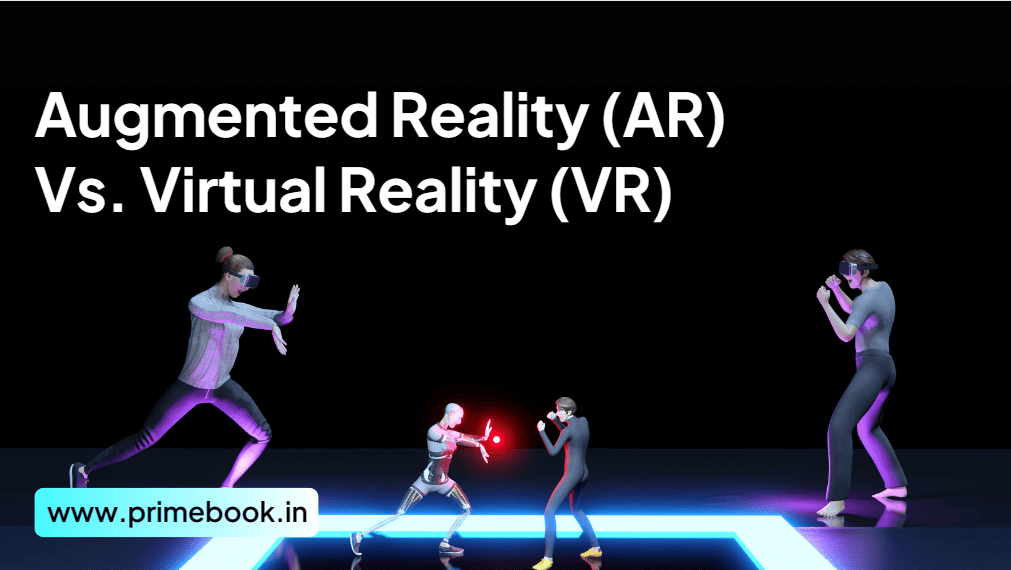Blogs / Trendy Tech Talks / Augmented Reality (AR) Vs. Virtual Reality (VR): The Main Differences!
Blogs / Trendy Tech Talks / Augmented Reality (AR) Vs. Virtual Reality (VR): The Main Differences!

Ananya Dasgupta
03 Apr 2024

Augmented Reality (AR) Vs. Virtual Reality (VR): The Main Differences!
Table of Contents
No doubt, you may often get confused between augmented reality (AR) and virtual reality (VR) for the enriching sci-fi experiences they offer. However, they are not the same! Although both AR and VR are transforming the world and our perception associated with modern technologies, they have a fine line of difference. This blog aims to delve into the key differences between AR and VR to help you understand the technologies and their utilities better.
What is AR? Vs. What is VR?
Augmented Reality or AR is typically the augmented or supplementary view of the real world with added computer-generated layers and objects on the top. This technology transforms the mundane aspects of the physical world into vibrant, visually appealing pictures and characters via video viewer or phone camera.
Whereas virtual reality or VR is the virtually-enabled simulation of the real-world environment. It supersedes your immediate external vision with immersive and interactive computer-generated sights and sounds. This means VR completely replaces the real world and places users in a realistic alternative world.
How Does AR Work? Vs. How Does VR Work?
There are differences in the way AR and VR work. On one side, AR utilizes a real-world setting to give an interactive digital experience, and the users are aware of and can control their presence in the physical world when experiencing it. On the other, VR is completely virtual, and the users are isolated from the physical environment and controlled by the system when experiencing this.
While a smartphone or tablet and AR apps are enough to experience augmented reality, you need a VR headset, glasses, gloves, collaborative tools, and other similar devices to get the immersive virtual experience. AR can work with simple technology, but VR needs powerful software and hardware to curate realistic experiences. Virtual reality (VR) tends to elevate a functional reality for the users. However, augmented reality (AR) elevates both the virtual and real worlds for the users.
Examples of AR Vs. Examples of VR
Some of the popular examples of AR are Pokemon Go, Google Street View, Google Glass, Google ARCore, Microsoft’s HoloLens, Snapchat, Google Expeditions, PEZ Play, IKEA Place Furniture App, Gucci’s AR Shoes, The Metro AR Newspaper, Pepsi MAX Bus Shelter, etc.
In contrast, a few renowned examples of VR are HTC Vibe, Play Station VR, Beat Saber, Steam’s VR Museum of Fine Art, Birdly VR, Lone Echo, Welcome to Light Fields, Nefertari, Behemoth VR, Arizona Sunshine 2, Bow-Bots, Colosse, The Guardian VR, Gravity Sketch, Dreams, and more.
Types of AR Vs. Types of VR
As stated in Forbes, there are two types of augmented reality (AR), namely – Marker-based AR and Marker-less AR. The former is typically the one using markers, like QR codes, images, or logos, to activate the AR experience and place the digital elements over the real-world environment. As the name suggests, the latter doesn’t require any marker but shall incorporate the digital elements over the recognizable patterns, colours, and features simply by scanning it.
Likewise, virtual reality (VR) is of three types – Non-immersive VR, Semi-immersive VR, and Fully-immersive VR. Non-immersive VR is a computer-generated virtual experience where the users can’t directly interact with it but can control some characters or activities within it. Fully immersive VR is the most realistic simulation experience, blurring the lines between the physical and digital worlds. Such a technology stimulates the maximum possible senses, whether sight, sound, touch, smell, or taste. Semi-immersive VR is a relatively new development in this domain, where one can partially interact with the virtual environment.
To sum up, both AR and VR are revolutionary technologies paving the future of various industries with innovative applications and unique experiences. Both are reconfiguring the ways we interact and engage with our surroundings in everyday life. However, they have differences in the way they work. While AR is more flexible and is therefore, versatile in its application, the world of VR needs more exploration to excavate its fullest potential.


 Related Blog
Related Blog









